
Saga pedo is a species of wingless bush cricket from the southern half of Europe and western and central Asia. This brown or green bush cricket typically has a total length, from the head to the tip of the ovipositor, of up to 10.5 cm (4.1 in), but exceptionally it may reach 12 cm (4.7 in), which makes it one of the largest European insects and one of the world's largest Orthoptera. The head-and-body alone typically is 5–7 cm (2.0–2.8 in) long in adults, but may reach up to 7.8 cm (3.1 in).

Calliptamus siciliae, commonly known as the pygmy pincer grasshopper, is a species of short-horned grasshoppers belonging to the family Acrididae subfamily Calliptaminae.

Metaplastes pulchripennis, common name Italian ornate bush-cricket, is a species of 'katydids crickets' belonging to the family Tettigoniidae subfamily Phaneropterinae.

Phaneroptera nana, common name southern sickle bush-cricket, is a species in the family Tettigoniidae and subfamily Phaneropterinae. It has become an invasive species in California where it may be called the Mediterranean katydid.

Tylopsis lilifolia, the lily bush-cricket, is a species of Orthopterans in the subfamily Phaneropterinae. It is found in Europe and Asia.

Pholidoptera fallax is a species of 'katydids crickets' belonging to the family Tettigoniidae subfamily Tettigoniinae.

Yersinella raymondii, common name Raymond's bush-cricket, is a species of "katydids crickets" belonging to the family Tettigoniidae subfamily Tettigoniinae. The scientific name Yersinella comes from the name of the entomologist who has described the species in 1860.

Conocephalus fuscus, the long-winged conehead, is a member of the family Tettigoniidae, the bush-crickets and is distributed through much of Europe and temperate Asia. This bush-cricket is native to the British Isles where it may confused with the short-winged conehead. These two species are phenotypically similar; however, the distinguishing factor between the two is the fully developed set of wings the long-winged conehead possesses that allows for flight. In the short-winged coneheads the hind wings are shorter than the abdomen, causing the wings to be vestigial and the species is incapable of flight. For this reason it is hard to discriminate between the two species during the early stages of their life cycle before the wings have fully developed. The colouration of the conehead is typically a grass green with a distinctive brown stripe down its back, though there are some brown phenotypes.
Panoploscelis is a genus of very large insects belonging to the true katydid tribe Eucocconotini, which is a subfamily of the Tettigoniidae. Like the other members of the suborder Ensifera, Panoploscelis are part of the insect order Orthoptera, which also contains crickets, grasshoppers and locusts. Members of this genus are among the largest katydids of the Neotropics.

Barbitistes obtusus, the southern saw-tailed bush-cricket or Alpine saw bush-cricket, is a species of bush crickets in the subfamily Phaneropterinae.

Ephippiger provincialis, the Provence saddle-backed bush cricket, is a species in the family Tettigoniidae.

Antaxius pedestris is a species of "bush crickets" belonging to the family Tettigoniidae. It was originally described by Johan Christian Fabricius under the scientific name of Locusta pedestris.

Grylloidea is the superfamily of insects, in the order Orthoptera, known as crickets. It includes the "true crickets", scaly crickets, wood crickets and other families, some only known from fossils.

Phymateus aegrotus, sometimes called the blue bush locust or East African bush locust, is a pest species of grasshopper in the family Pyrgomorphidae. Unlike "locusts" the adults are not known to change their morphology on crowding, but at the hopper stage, marching behaviour of small bands may occur.
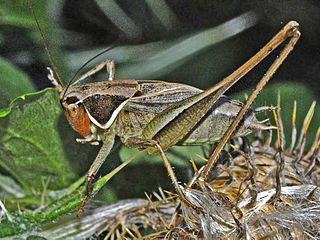
Sepiana sepium, common name sepia bush-cricket, is a species of bush crickets belonging to the tribe Platycleidini and genus group Platycleis. It is the only species within the monotypic genus Sepiana.

Leptophyes is a genus of bush-crickets found in Africa, Asia, and Europe. The genus was erected by Franz Xaver Fieber in 1853.
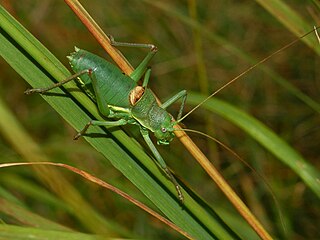
Ephippiger perforatus, the North Apennine saddle bush-cricket, is a species of insect in the family Tettigoniidae.
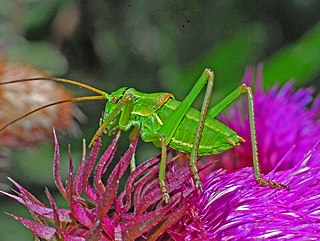
Ephippiger terrestris, common name Alpine saddle-backed bush-cricket, is a bush cricket species belonging to the family Tettigoniidae, subfamily Bradyporinae.
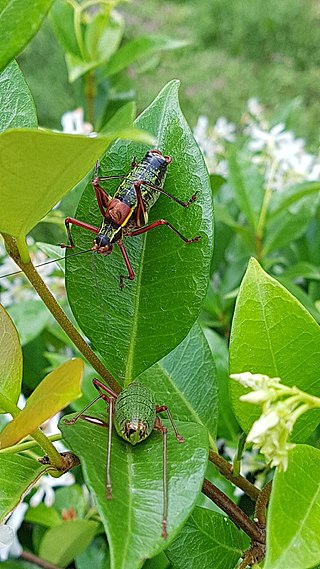
Barbitistes vicetinus, the Vicentine saw-tailed bush-cricket, is a species of katydids crickets in family Phaneropteridae endemic to Italy. The species was originally described by Antonio Galvagni and Paolo Fontana. It is found in vineyards and woody vegetation in the regions of Veneto and Trentino, in particular in the province of Vicenza. In 2016, it was listed as a Near Threatened species by the IUCN due to its restricted geographic range and extreme fluctuations in its population: its current extent of occurrence (EOO) is about 580 km2 (220 sq mi), and its area of occupancy (AOO) is between 50–100 km2 (19–39 sq mi). Formally described as a new species only in 1993, unexpected population outbreaks have severely impacted forests and crops in northern Italy in recent years.
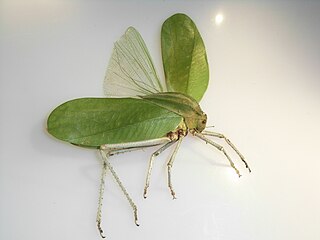
Siliquofera is a genus of bush cricket in the subfamily Phyllophorinae that includes only one species, Siliquofera grandis, which is fairly common and widespread in rainforest canopies of New Guinea and nearby smaller islands, and seemingly rare in Australia where only found in the remote Iron Range region. This very well-camouflaged, green and leaf-like bush cricket is one of the world's largest Orthoptera, with adults typically having a length of 10.7–13 cm (4.2–5.1 in) and a wingspan of 25–27 cm (9.8–10.6 in); it can weigh more than 30 g (1.1 oz).




















